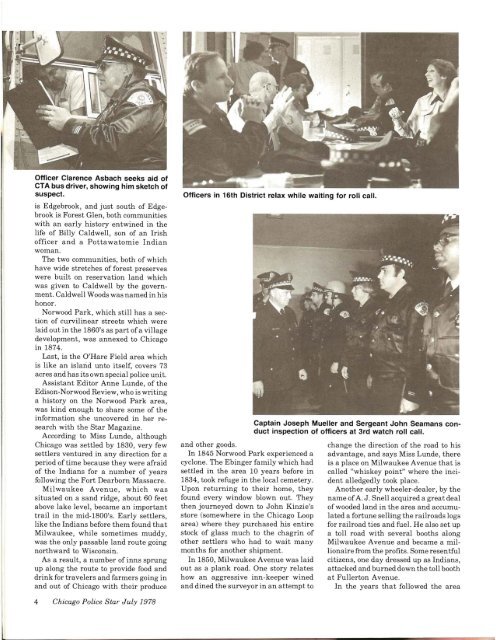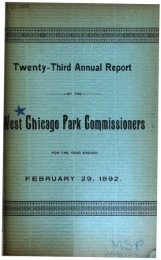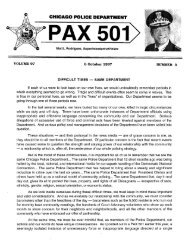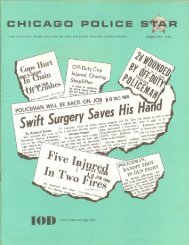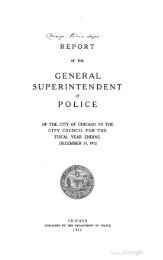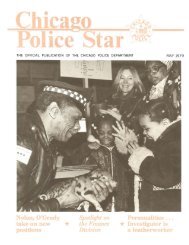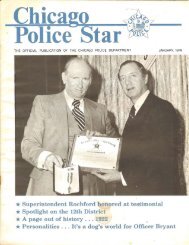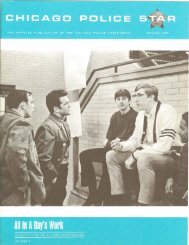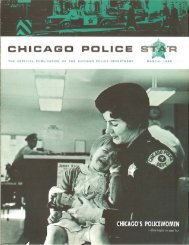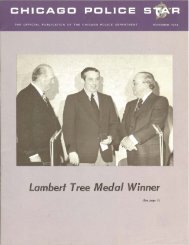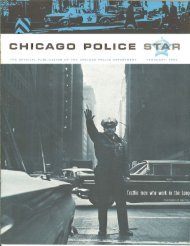'Officer Nunzio' and friend - Chicago Cop.com
'Officer Nunzio' and friend - Chicago Cop.com
'Officer Nunzio' and friend - Chicago Cop.com
You also want an ePaper? Increase the reach of your titles
YUMPU automatically turns print PDFs into web optimized ePapers that Google loves.
Officer Clarence Asbach seeks aid of<br />
CTA bus driver, showing him sketch of<br />
suspect.<br />
is Edgebrook, <strong>and</strong> just south of Edgebrook<br />
is Forest Glen, both <strong>com</strong>munities<br />
with an early history entwined in the<br />
life of Billy Caldwell, son of an Irish<br />
officer <strong>and</strong> a Pottawatomie Indian<br />
woman.<br />
The two <strong>com</strong>munities, both of which<br />
have wide stretches of forest preserves<br />
were built on reservation l<strong>and</strong> which<br />
was given to Caldwell by the government.<br />
Caldwell Woods was named in his<br />
honor.<br />
Norwood Park, which still has a section<br />
of curvilinear streets which were<br />
laid out in the 1860's as part ofa village<br />
development, was annexed to <strong>Chicago</strong><br />
in 1874.<br />
Last, is the O'Hare Field area which<br />
is like an isl<strong>and</strong> unto itself, covers 73<br />
acres <strong>and</strong> has its own special police unit.<br />
Assistant Editor Anne Lunde, of the<br />
Edison-Norwood Review, who is writing<br />
a history on the Norwood Park area,<br />
was kind enough to share some of the<br />
information she uncovered in her research<br />
with the Star Magazine.<br />
According to Miss Lunde, although<br />
<strong>Chicago</strong> was settled by 1830, very few<br />
settlers ventured in any direction for a<br />
period of time because they were afraid<br />
of the Indians for a number of years<br />
following the Fort Dearborn Massacre.<br />
Milwaukee Avenue, which was<br />
situated on a s<strong>and</strong> ridge, about 60 feet<br />
above lake level, became an important<br />
trail in the mid-1800's. Early settlers,<br />
like the Indians before them found that<br />
Milwaukee, while sometimes muddy,<br />
was the only passable l<strong>and</strong> route going<br />
northward to Wisconsin.<br />
As a result, a number of inns sprung<br />
up along the route to provide food <strong>and</strong><br />
drink for travelers <strong>and</strong> farmers going in<br />
<strong>and</strong> out of <strong>Chicago</strong> with their produce<br />
4 <strong>Chicago</strong> Police Star July 1978<br />
Officers in 16th District relax while waiting for roll call.<br />
<strong>and</strong> other goods.<br />
In 1845 Norwood Park experienced a<br />
cyclone. The Ebinger family which had<br />
settled in the area 10 years before in<br />
1834, took refuge in the local cemetery.<br />
Upon returning to their home, they<br />
found every window blown out. They<br />
then journeyed down to John Kinzie's<br />
store (somewhere in the <strong>Chicago</strong> Loop<br />
area) where they purchased his entire<br />
stock of glass much to the chagrin of<br />
other settlers who had to wait many<br />
months for another shipment.<br />
In 1850, Milwaukee Avenue was laid<br />
out as a plank road. One story relates<br />
how an aggressive inn-keeper wined<br />
<strong>and</strong> dined the surveyor in an attempt to<br />
Captain Joseph Mueller <strong>and</strong> Sergeant John Seamans conduct<br />
inspection of officers at 3rd watch roll call.<br />
change the direction of the road to his<br />
advantage, <strong>and</strong> says Miss Lunde, there<br />
is a place on Milwaukee Avenue that is<br />
called "whiskey point" where the incident<br />
alledgedly took place.<br />
Another early wheeler-dealer, by the<br />
name ofA. J. Snell acquired a great deal<br />
of wooded l<strong>and</strong> in the area <strong>and</strong> accumulated<br />
a fortune selling the railroads logs<br />
for railroad ties <strong>and</strong> fuel. He also set up<br />
a toll road with several booths along<br />
Milwaukee Avenue <strong>and</strong> became a millionaire<br />
from the profits. Some resentful<br />
citizens, one day dressed up as Indians,<br />
attacked <strong>and</strong> burned down the toll booth<br />
at Fullerton Avenue.<br />
In the years that followed the area


